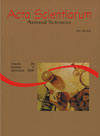<b>Morphology of digestive and non-digestive organs of pigs from modern lineages during growth, finishing and post-finishing phases</b> - DOI: 10.4025/actascianimsci.v29i3.553
Abstract
The genetic market makes use of various modern swine genotypes that present high capacity for muscular mass development. These genetic lines have been used in swine production without existing scientific information about morphology, knowledge that can elucidate factors related to growth performance, such as weight gain and food conversion in lean meat yield. The aim of this experiment was to compare the morphology of digestive and non-digestive organs of modern genotypes. At the end of the phases: Growing I, Growing II, Finishing and Post-finishing, the pigs were slaughtered and the organs were weighed. The weight of the organs decreased (p < 0.01) with body development, in agreement with the biological growth of the animals. The morphology of the digestive organs were different (p < 0.06) among lineages, which showed that differences can exist, mainly regarding digestive capacity and, possibly, food intake and efficiency. The length of the small intestine was different (p < 0.06) among lines, which can be an indicative of increased body development due to an extended food exposition area to intestinal cells. The scientific knowledge of swine lines morphology is important because this information can contribute to animal growth performance.Downloads
Download data is not yet available.
Published
2007-12-14
How to Cite
Gomes, J. D. F., Putrino, S. M., Martinelli, M. dos R., Ishi, M. de P., Sobral, P. J. do A., & Fukushima, R. S. (2007). <b>Morphology of digestive and non-digestive organs of pigs from modern lineages during growth, finishing and post-finishing phases</b> - DOI: 10.4025/actascianimsci.v29i3.553. Acta Scientiarum. Animal Sciences, 29(3), 261-266. https://doi.org/10.4025/actascianimsci.v29i3.553
Issue
Section
Nonruminant Nutrition
DECLARATION OF ORIGINALITY AND COPYRIGHTS
- I Declare that current article is original and has not been submitted for publication, in part or in whole, to any other national or international journal.
The copyrights belong exclusively to the authors. Published content is licensed under Creative Commons Attribution 4.0 (CC BY 4.0) guidelines, which allows sharing (copy and distribution of the material in any medium or format) and adaptation (remix, transform, and build upon the material) for any purpose, even commercially, under the terms of attribution.
Read this link for further information on how to use CC BY 4.0 properly.
0.9
2019CiteScore
29th percentile
Powered by 








































